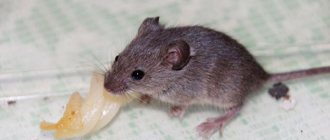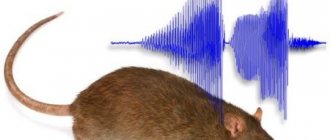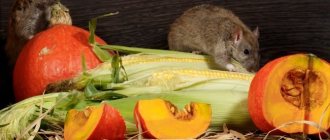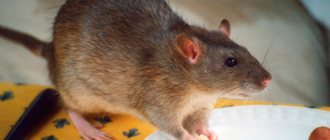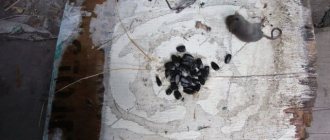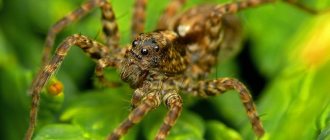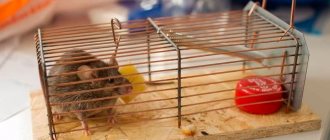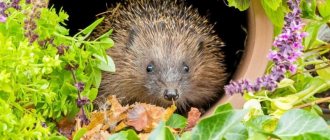Mice and rats are unpleasant guests in the house and on the farmland. The owners try to get rid of them by any means possible. Mouse bait is prepared from various products. It is placed in a trap to capture and kill animals.
- What do mice eat?
- What smell attracts mice?
- Selection of traps
- How to choose the right bait
- What's the best thing to put in bait? Salted or smoked lard
- Vegetable oil
- Grains and baked goods
- Cold smoked fish
- Sausage
- Cheese
- Raw minced meat with onions
- Baits that are not suitable for catching mice
What do mice eat?
Mice belong to the order of rodents. The size of the animals is 5-10 cm. In nature, their diet consists of cereal grains, plant fruits, root vegetables, mushrooms, nuts, insects and carrion. Mice breed up to four times a year and multiply quickly. They cause damage to agriculture and households.
Rodents love to live near humans. In winter, animals are forced to look for food. They penetrate houses and apartments. They eat leftover human food (bread, sausage, cereals, cheese, cookies, fruits, vegetables).
In search of food, mice look for loopholes and cracks in houses. They gnaw holes in wood and building materials. If a mouse is hungry, it can eat paper or cardboard.
Causes of mice
With the onset of cold weather, the risk of “uninvited guests” appearing in a person’s home increases. In summer, there is enough food in fields and garbage dumps, and mice are less likely to get into apartments and houses.
In late autumn, the harvest is harvested, the remains are eaten, frozen food waste is not to the taste of rodents. What to do? Go in search of food and warm shelter. For this reason, mice and rats enter cellars, apartments in high-rise buildings, granaries, storerooms, and private houses. From basements, rodents reach not only the first floors, but often climb higher along the floors. Rats in a chicken coop also bring a lot of trouble.
A simple test will help you understand how high the risk of encountering mice in your home is. For each “Yes” answer, score 1 point, for each “No” – 0 points.
Questions:
- Do dirty dishes often end up in the sink?
- Do owners always wipe down the dining table immediately after eating?
- How long does a trash can with rotting waste last?
- Are there any spilled cereals, flour, pasta, or seeds on the shelves of the kitchen cabinet?
- How cluttered is the pantry: a lot of garbage, old things or not?
- Is there a garbage dump or food waste bins near your house?
- Is it easy to find freely available water (pipes are leaking, there are often wet rags on the floor)?
- Are crumbs on the table or kitchen floor a common occurrence?
- Are containers with bulk products tightly closed?
- Does the housewife buy flour and cereals “in reserve”?
- Are there holes in the baseboards, near sewer pipes, in the floor, or in the walls of the cellar?
- Do the owners keep poultry?
Got 3 or more positive responses? We will have to urgently reconsider our attitude towards order and pay more attention to protecting the home from rodents
How to get rid of weevils in an apartment and preserve food supplies from harmful bugs? We have the answer!
What smell attracts mice?
Rodents have poor eyesight, so other senses are highly developed: smell, touch, hearing. Mice are selective eaters. The smell of their favorite foods lures them in, while dangerous substances repel them. To know what to catch rats or mice with and what baits are guaranteed to work, you need to study the scents that attract them.
Rodents like the smells of the following foods:
- bakery products;
- vegetable oils;
- salted fish;
- meat;
- lard;
- sausages;
- snacks (chips, nuts, crackers);
- beer.
Note! The fresher the product, the stronger its aroma. If a mouse smells the chemicals, it will pass by.
Rats are less picky; they eat everything. But if one animal feels bad after eating, the rest will not eat the food.
Sausage
Sausage, although it consists of meat, is still not very popular with mice. Rats love sausage much more.
As a rule, in the home, mice always have access to all the food they can find. However, when the house is hungry, mice may not disdain a piece of smoked or raw sausage.
If you still want to use sausage when catching mice, you will have to fork out and buy a very expensive stick, but it is much easier to just use a piece of meat or lard.
Sausage contains a lot of chemicals, so it is harmful not only to the body of mice, but also to people.
Selection of traps
In the fight against rodents, special devices are used. Let's look at how to choose a mousetrap or rat trap.
The traps have a similar mechanism of action, but differ in size. The body length of rats reaches 30 cm, which is 5-6 times the size of mice. Traps are made of wood, plastic, and metal.
The following types of products are supplied to stores:
- Mechanical (trap, snare). They are a simple design that pinches and suffocates the rodent, preventing it from getting out. The bait is placed in a mousetrap. The bait should be attractive to mice. The mechanism is triggered when the animal reaches the food.
- Electrical. The pest killer comes in the form of a plastic container with a built-in mechanism that delivers an electric shock. The bait is placed inside, the rodent climbs in for food and dies from electric shock.
- Live traps. They are made in the form of cages and boxes. After catching the pest, it is released far from home.
- Glue traps are boards with a sticky coating, once on which a mouse cannot escape.
The devices kill or leave animals alive. The device is cleaned after each use.
Homemade mousetraps are made from plastic bottles, glass jars, and buckets. Place bait (seeds, grains, flour, lard, etc.) into the container and approach the neck. The mouse ends up in a container and can't get out.
Catching a large rodent is difficult, since luring a rat into a rat trap is quite difficult. The cunning design is made from pipe scraps, and a fragrant bait is placed at the end. The tunnel is built on the principle of a swing. When an animal walks over it, the device tilts. The beast falls into a deep basin. To be safe, pour water into the container.
Types of plastic traps
Rat traps are divided into 2 types: killing and humane. Rats are removed from homes because they damage walls, spoil food, and spread disease. The average individual easily makes a hole in a thin-walled plastic pipe; their bite is painful.
Farmers consider such pests to be their first enemies. Rats destroy chickens and other small animals; often these animals kill young piglets. Rodents are dangerous for babies sleeping at night, since hunger forces rats to attack even them. The home owner can use one of two options: make a rat trap with your own hands or purchase a factory product.
This is not to say that homemade traps are better or worse than factory ones, but they open up creative scope for the creator
Vertical device
To make a homemade trap you will need a 2 liter plastic bottle. Experienced rat catchers construct the product according to the following principle:
- Use scissors to remove the neck of the container.
- 2 cm are retreated from the cut part downwards and a hole is made with a needle.
- A fishing line or nylon thread is inserted into the hole and a strong knot is created.
- The second edge of the cord is tied to a mounted object on the kitchen table.
- Bait is placed in the bottle.
This video shows the top 5 best homemade mousetraps:
Horizontal design
Horizontal traps give a good effect. They are installed above a bucket of water. The process of making a killing trap:
- Symmetrical holes are made at the bottom and cap of the bottle. A wooden or metal rod is inserted there, the edges of which protrude 5-10 cm from the container. A trap is placed on them between two objects and secured.
- Bread treated with sunflower oil is attached to the surface of the rotating structure with tape. The bait is placed in the center of the fishing container.
- Since it is difficult for the animal to climb inside the rat trap, a wooden or cardboard ladder is built.
A horizontal trap with a bucket of water is the most effective among homemade ones.
Plastic “trap pit”
Another type of effective device for catching pests, which can be done in a short time. Main material: 5L plastic bottle. Step-by-step construction:
- Step back 10 cm from the neck, draw a line and cut off the excess part.
- A landscape sheet is placed on top of the cut and secured with tape.
- A cross-shaped cut is made in the middle of the paper.
- A stick is made in the shape of the letter “L”, tied to the product and equipped with a bait hanging over the center of the cut.
- A wooden ladder is placed on the structure.
The basic principle of the pit trap is to lure the rat onto a piece of paper with slots in it.
Product made from sharp petals
The principle of operation of a trap is similar to the trapping pit device. You will need a large bottle. Craftsmen do this:
- The top part with the neck is removed from the container. The hole diameter is at least 8 cm.
- Step back 10 cm from the cut and draw a line around the circumference. Using scissors, cut strips 1 cm wide.
- Oiled bread is placed inside the homemade product.
- The edges of the petals are folded into the middle.
- A wooden plank serves as a ladder.
The pest will want to climb inside the container for the bait, put its paws on the petals and fall into the structure. Sharp stripes will prevent the rat from getting out. In one night, the product catches a dozen rodents.
How to choose the right bait
Bait is placed in a trap for the purpose of catching or baiting animals. Lures are divided into two types:
- Food;
- poison and poisonous mixtures.
Bait is selected depending on the type of trap. If it is a snare or a trap, then solid pieces of food are used; if it is an adhesive coating, then bulk products (seeds, cereals) can be used.
It is recommended to add poisonous powders to food. Stores sell formulations based on grains, meat, and waxed briquettes. The bait is laid out in small parts throughout the area. Having eaten a piece, the pest dies on the spot or manages to go into the nest and die there.
Prepare your own mixture with quick-hardening dry building materials. The bait is mixed with alabaster. After eating it and drinking water, the rodent dies from the plaster hardening inside.
Note! When setting traps, there is no point in preparing toxic mixtures. It is enough to load the mousetrap with attractive bait.
To prevent the smell from pushing people away from food, you should prepare the bait correctly - wearing protective clothing and gloves.
What's the best thing to put in bait?
Rodents that have appeared in the house are looking for food. But at the same time, they are wary of unfamiliar structures, even if they contain food. To ensure pests are caught in the trap, you need to use certain types of food.
Salted or smoked lard
The salty taste and smoky smell of lard is of greatest interest to rodents. To effectively attract parasites, bait is prepared from a fried product. Cracklings are placed in any trap.
Using lard is economical, since you can simply soak bread, crackers, or grains in the remaining fat.
It is necessary to place the bait in such a way that the animal cannot pull out a piece and run away with it. Rats do this especially skillfully.
Vegetable oil
The aroma of sunflower seeds attracts mice. The same applies to sunflower oil. The animal will not lick it, but it will be attracted to a soaked, buttery piece of bread, pancake, leftover pie, or pizza crust. Use unrefined fresh oil or the oil left over from frying meat dishes.
It is enough to put several pieces on one trap. This bait is not suitable for rats.
Grains and baked goods
The smell of freshly baked bread spreads far beyond the house. Mice love baked goods and are drawn to the aroma. It is better if seeds, bran, and whole grains are added to the bread.
The following is poured into the traps:
- barley;
- wheat;
- rice;
- buckwheat;
- pumpkin and sunflower seeds;
- small nuts.
Seeds or grains soaked in poison are suitable baits for sticky traps or containers.
Cold smoked fish
Anything smoked attracts rodents, including fish. Cold smoking thickens the product and makes it convenient to use in traps. Rats and mice react to fresh food. They will not go well with rotten fish.
It is expensive and time consuming to prepare fish especially for catching mice. Therefore, such bait is rarely used.
Sausage
Mice and rats react similarly to sausage. The composition of semi-finished products varies greatly. In addition to meat, fillers, flavors, and emulsifiers are added to them. If other food is available, rodents will not eat cheap sausage.
The best option for them is smoked sausage or good quality meat. You may have to try products from different manufacturers for bait.
Cheese
House mice and rats, contrary to popular belief, are calm about cheese. They don't like the smell of fermented milk products. Unless the cheese is smoked. The trapped piece will be eaten if there is no more tasty food nearby. Rodents will disdain dry crust.
Raw minced meat with onions
The bait is more suitable for catching rats. They are carnivores; meat is part of their diet. To make the smell spread over a greater distance and become more pronounced, onions are added to the mixture.
It is convenient to mix poison into such bait. The disadvantage of bait is that it quickly deteriorates. Mice and rats do not eat rotten meat.
Baits that are not suitable for catching mice
When mice appear in the house, they seem to eat everything. But if you try to catch them, some products are not suitable for bait.
These include:
- spoiled meat, missing sausage, rotten lard;
- fermented milk products;
- food with a lot of dyes and flavors;
- rancid oil;
- dried foods;
- peppered food;
- seasonings
Important! If there are children in the house, then pesticides are not used. The same applies to pets. A pet that catches and eats a poisoned mouse may die.
What do rodents like?
Biologists and professional deratizers (pest extermination specialists) agree that mice are more often “led” to delicacies of plant origin, while rats love animal products. But when a rodent has been hungry for a long time, it will eat whatever it finds. That is why at first it is difficult to determine who is in the house. In view of what has been described, employees of non-food industry enterprises resort to a trick - they use poisoned grain to destroy parasites. It’s cheap and works 100%, because pests have no other food.
Mice
Based on the above, the best mouse baits are:
- fresh baked goods - a fragrant wheat bun, muffin, gingerbread or a piece of soft white bread will attract the pest almost instantly;
- seeds - in the wild, mice eat grains and willingly feast on them in our homes;
- nut – as appetizing as grains;
- a slice of apple, pear, plum or peach - familiar fruits with a bright smell often become food for mice in the wild;
- peanut butter - nut paste has a pronounced aroma and smells fragrant for many meters.
Rats
Rats are practically omnivorous. They can be caught using any delicacy, but we recommend:
- lard is a product with a bright, spicy aroma that attracts rodents like a magnet;
- sausage - only high-quality sausage products will do; rats often refuse cheap ones, stuffed with chemicals;
- fresh meat - the specific smell that various parts of a chicken or pig carcass emit attracts pests;
- minced meat is an almost ideal bait for rats, better with the addition of onions;
- smoked fish is a very flavorful option that can catch the maximum number of rodents;
- vegetable oil – “fragrant” unrefined sunflower oil can be used in combination with a piece of bread.
Conclusion
The fight against rodents due to their large numbers is a long process. During it, the following methods and devices are used:
- Traps - mechanical traps, electric containers, live traps, nets.
- Baits are prepared from flour, grains, seeds, lard, sausage, and eggs. Products are placed in traps in their pure form, or mixed with poison and placed along the passages of animals.
- To prevent mice from getting used to the bait, it is changed every three days.
- Food used as bait must be fresh. Pests will not be attracted to spoiled food.
Bait is important when catching rodents. It helps to lure animals into traps and clear the house of parasites.
How to catch a mouse
Are you afraid of mice?
Very Not a drop
There are several different ways to catch a mouse alive or kill it. These are various poisons, traps, live traps and electronic repellers.
Expert opinion
Evgeniy Koshalev
I dig in the garden at the dacha until the last rays of sunshine every day. No specialty, just an amateur with experience.
They say that a proven way to prevent mice is to have a cat in the house. In my example, and I have 2 fat purrs, this does not work. The most popular to this day are mousetraps. They can be of various kinds, purchased or homemade. You can read about how to make and choose mousetraps here.
Which bait to choose
There are several of the simplest and most effective baits. The main thing is that they retain their appearance and smell for a long time.
It is believed that mice love cheese. This is what is often used in bait. However, there are conflicting opinions on this matter. Is this true or not?
Purchased baits
These are chemicals, poisons that kill animals. Some of them are immediate, while others act gradually and have a cumulative effect. Of these, there are several of the most common.
If you had to use glue traps, and they had an effect not only on a rodent, I advise you to read the article on how to clean glue from mice.
